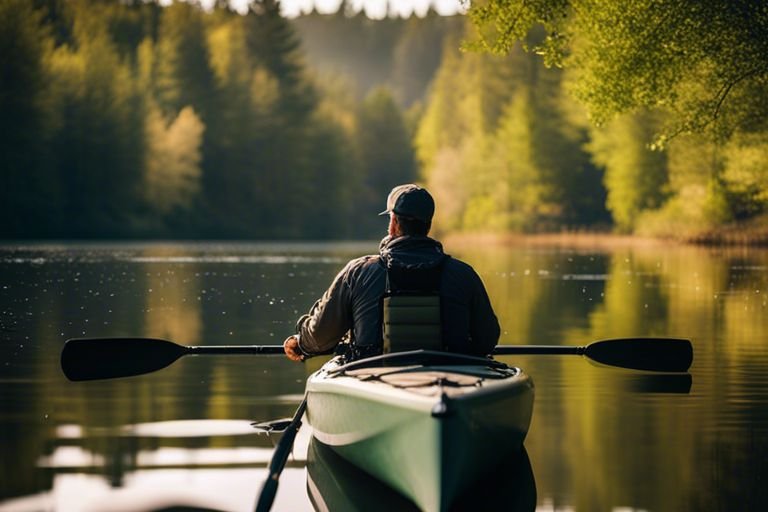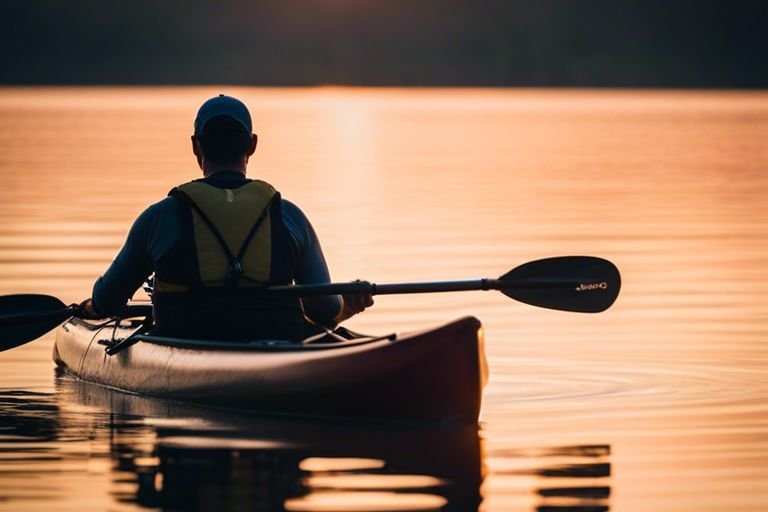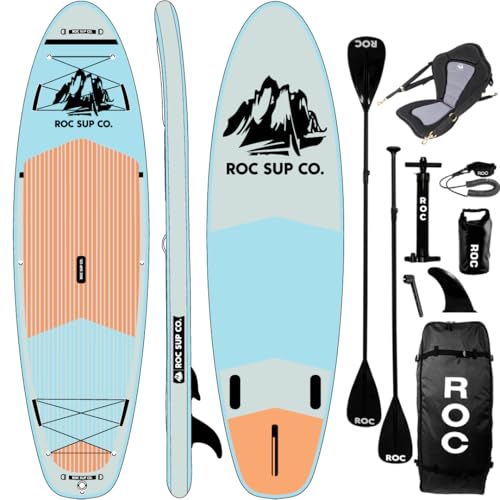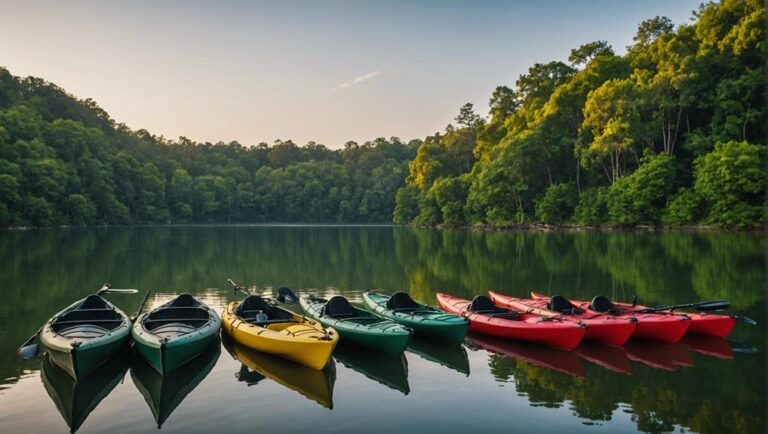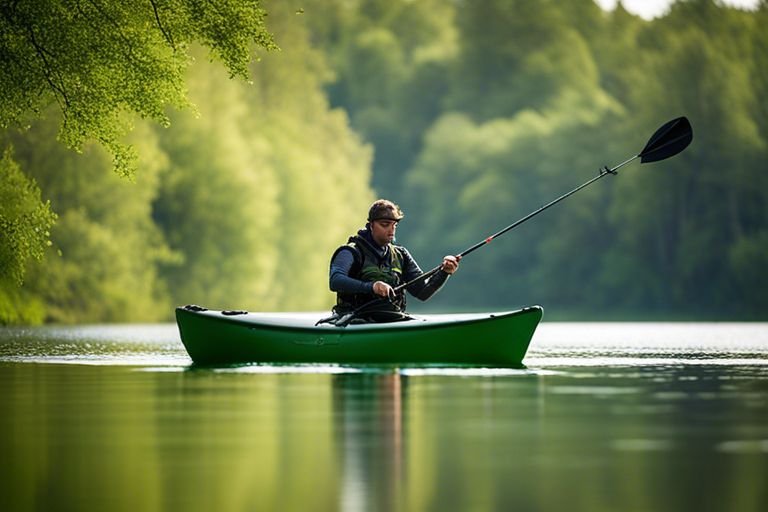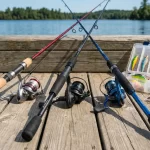As I reflect on my 25+ years of fishing, I can confidently say that kayak fishing offers a unique sense of freedom and excitement that’s hard to match.
But, I’ve learned the hard way that having the right fishing kayak is crucial to a successful and enjoyable experience.
With so many options available, it can be overwhelming to choose the perfect one. That’s why I’m sharing my expertise to help you avoid the frustration and discomfort that comes with choosing the wrong kayak.
Whether you’re a seasoned angler or just starting, this guide will walk you through the key factors to consider when selecting a fishing kayak that’s right for you.
For a more in-depth look at the process, check out this article on Choosing the Right Fishing Kayak.
Key Takeaways:
- Type of Kayak Matters: There are three main types of fishing kayaks: sit-on-top, sit-in, and inflatable kayaks, each with its own strengths and weaknesses. Choose the right one based on your fishing style and preferences.
- Consider the Water Conditions: The type of water you’ll be fishing in most often affects your choice of kayak length, width, and features. Think about stability, speed, and maneuverability when selecting a kayak.
- Weight Capacity and Comfort are Crucial: Ensure your kayak can comfortably support your weight and gear, and look for adjustable seating options with good lumbar support to prevent backaches.
- Storage and Fishing-Specific Features are Essential: Consider the storage space you need for your gear and choose a kayak with features like rod holders, hatches, tank wells, and bungee cords. Additional features like live wells and fish finder mounts can enhance your fishing experience.
- Choose a Kayak that Enhances Your Experience: Select a kayak that fits your fishing style, experience level, and budget. With the right kayak, you can focus on the thrill of the catch and the tranquility of nature.
Understanding the Types of Fishing Kayaks
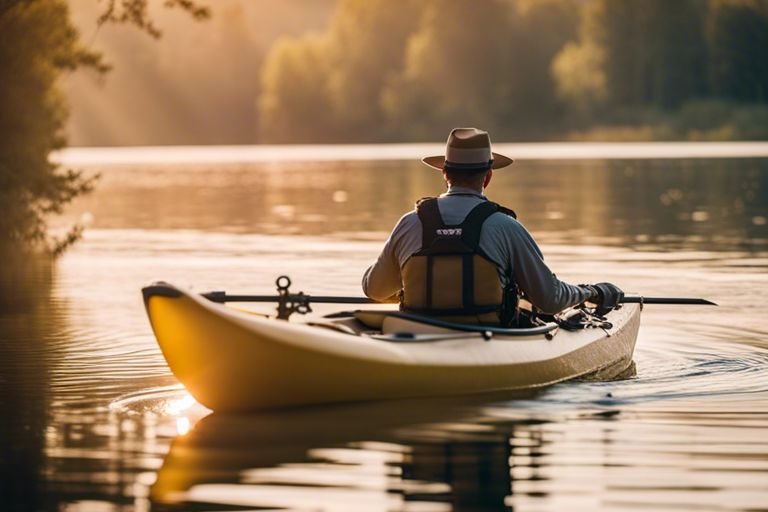
Before we explore the specifics of choosing the right fishing kayak, it’s vital to understand the different types available in the market.
Each type is designed with unique features and capabilities, catering to various fishing styles, preferences, and environments.
Here are the three main types of fishing kayaks:
- Sit-on-Top Kayaks: Known for their stability and ease of use, these kayaks are perfect for beginners and experienced anglers alike.
- Sit-in Kayaks: Offering a drier ride and better suited for colder conditions, sit-in kayaks provide a bit more speed and efficiency.
- Inflatable Kayaks: Portable and affordable, inflatable kayaks are ideal for anglers with limited storage space.
For a more in-depth look at each type, check out A Beginner’s Guide to Kayak Fishing.
| Type of Kayak | Key Features |
|---|---|
| Sit-on-Top Kayaks | Stability, ease of use, self-bailing, stand-up capabilities |
| Sit-in Kayaks | Drier ride, speed, efficiency, better suited for colder conditions |
| Inflatable Kayaks | Portability, affordability, easy storage and transport |
| All Kayaks | Comfortable seating, storage options, rod holders, fishing-specific features |
Sit-on-Top Kayaks: Stability and Ease of Use
There’s a reason why sit-on-top kayaks are incredibly popular among anglers – they offer unparalleled stability and ease of use.
These kayaks are perfect for beginners, as they’re easy to get in and out of and provide a sense of security while fishing.
One of the standout features of sit-on-top kayaks is their self-bailing design, which means they drain water automatically.
This feature, combined with the ability to stand up for better casting and visibility, makes them an excellent choice for fishing in calm waters.
Sit-in Kayaks: Speed and Efficiency
Now, if you’re looking for a kayak that provides a bit more speed and efficiency, sit-in kayaks are the way to go. These kayaks offer a drier ride, making them better suited for colder conditions, and are perfect for anglers who want to cover more water.
Kayaks with a sleeker design and narrower hulls tend to be faster and more efficient but may compromise on stability. It’s vital to find a balance between speed and stability, depending on your fishing style and preferences.
In addition to their speed and efficiency, sit-in kayaks often provide better protection from the elements, making them an excellent choice for anglers who fish in harsh weather conditions.
Inflatable Kayaks: Portability and Affordability
Any angler who’s short on storage space or wants a more affordable option should consider inflatable kayaks.
These kayaks are incredibly portable, easy to transport, and store, making them perfect for anglers with limited space.
This type of kayak is also an excellent choice for beginners, as they’re often more affordable than traditional kayaks.
Inflatable kayaks have come a long way in terms of durability and performance, offering a comfortable and stable ride.
In addition to their portability and affordability, inflatable kayaks are also surprisingly durable and can withstand rough waters. They’re an excellent option for anglers who want a hassle-free fishing experience.
Factors to Consider When Choosing a Fishing Kayak
If you’re new to kayak fishing, it can be overwhelming to navigate the numerous options available.
But as a seasoned angler, I’ve learned that there are several key factors to consider when choosing the right fishing kayak for your needs.
Here are some crucial considerations to keep in mind:
- Water type: Will you be fishing in calm lakes, navigating winding rivers, or braving choppy coastal waters?
- Weight capacity: Can your kayak comfortably support your weight, along with your gear and any potential catches?
- Comfort and ergonomics: Does the kayak have an adjustable seat with good lumbar support to prevent backaches?
- Storage options: Are there ample hatches, tank wells, and bungee cords to store your gear?
Water Type: Lakes, Rivers, and Coastal Waters
While lakes offer a serene and peaceful fishing experience, rivers require more agility and maneuverability to navigate through currents and obstacles.
Coastal waters, on the other hand, demand a kayak that can withstand rougher conditions and stronger winds.
When choosing a kayak for a specific water type, consider the length and width of the kayak. A longer kayak will provide more speed and efficiency, while a wider kayak will offer greater stability.
Weight Capacity: Supporting You and Your Gear
Any angler knows that gear can add up quickly, and you don’t want to be stuck with a kayak that can’t support your weight and equipment.
Look for a kayak with a weight capacity that exceeds your own weight, taking into account your gear, tackle boxes, and any potential catches.
A good rule of thumb is to add at least 50 pounds to your own weight to ensure a comfortable and safe ride.
It’s also crucial to consider the distribution of weight within the kayak. A kayak with a balanced design will provide better stability and maneuverability, making it easier to paddle and fish.
Comfort and Ergonomics: Seats and Lumbar Support
Lakes and rivers can be unforgiving, and a comfortable seat is crucial for a successful fishing trip.
Look for a kayak with an adjustable seat that provides good lumbar support. This will help prevent backaches and fatigue, allowing you to focus on the fishing.
Coastal fishing often requires longer paddling distances, making a comfortable seat even more critical.
Consider a kayak with a seat that can be adjusted to different positions, providing optimal comfort and support.
Storage Options: Hatches, Tank Wells, and Bungee Cords
The type of storage will depend on the type of gear you typically carry on your fishing trips.
Consider a kayak with multiple hatches and tank wells to store your gear, tackle boxes, and bait. Bungee cords can also be useful for securing loose items, such as nets or paddles.
Tank wells, in particular, are great for storing larger items, like coolers or tackle boxes. Look for a kayak with a tank well that’s easily accessible and has a secure lid to prevent items from shifting during paddling.
See Also: Understand Fishing Kayak Paddles
Fishing-Specific Features to Look For
After considering the overall design and functionality of your fishing kayak, it’s time to look into the features that make a kayak truly fishing-friendly.
These are the elements that will elevate your fishing experience and give you a competitive edge on the water.
Rod Holders: Built-in and Customizable Options
Look for kayaks with built-in rod holders that can securely store your rods when not in use. These holders should be sturdy, adjustable, and strategically placed to minimize clutter and maximize convenience.
Some kayaks offer customizable rod holder systems, allowing you to add or remove holders as needed.
This feature is a game-changer for anglers who like to switch between different rods and techniques throughout the day.
I’ve found that having multiple rod holders also enables me to keep my rods organized and within easy reach, reducing the time spent switching between rods and increasing my chances of landing more fish.
When choosing a kayak with rod holders, make sure they’re compatible with your rod type and size to ensure a secure fit.
Live Wells: Keeping Bait Fish Fresh
Fish care is crucial when using live bait, and a live well can make all the difference in keeping your bait fish healthy and lively.
A live well is importantly a tank that circulates water, providing a safe and comfortable environment for your bait fish.
This feature is especially important for anglers who rely on live bait to catch species like bass, trout, or walleye.
Wells with built-in aerators or pumps help maintain optimal water quality, which is important for keeping your bait fish fresh and active.
Some kayaks come with integrated live wells, while others offer optional live well systems that can be installed or attached to the kayak.
When choosing a kayak with a live well, consider the size of the tank, water circulation capabilities, and ease of maintenance.
Additionally, look for kayaks with features like drainage systems and overflow protection to prevent water from flooding the kayak or compromising the stability of the vessel.
Mounts for Fish Finders: Enhancing Your Fish-Finding Capabilities
Look for kayaks with built-in mounts or attachment points for fish finders, which can greatly enhance your ability to locate schools of fish and underwater structures.
These mounts should be sturdy, adjustable, and positioned to provide an optimal viewing angle.
I’ve found that having a fish finder mounted on my kayak has significantly improved my catch rate, as it allows me to quickly identify areas with high fish activity and adjust my fishing strategy accordingly.
When choosing a kayak with a fish finder mount, ensure that it’s compatible with your preferred fish finder model and consider the ease of installation and removal.
Built-in mounts can also accommodate other accessories like GPS devices, cameras, or even phone holders, further expanding your kayak’s functionality and versatility.
Tips for Choosing the Right Fishing Kayak
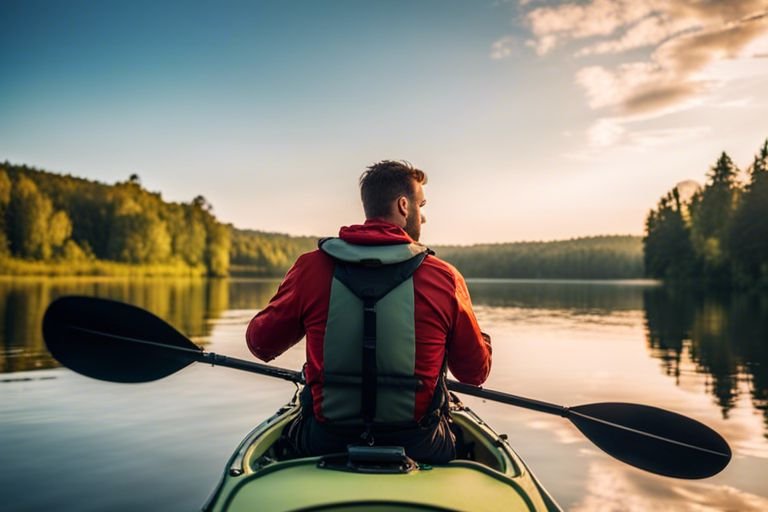
Once again, as a seasoned angler, I’ve learned that choosing the right fishing kayak is crucial to a successful and enjoyable experience on the water.
To help you make the best decision, I’ve compiled some vital tips to consider when selecting your ideal kayak.
- Assess your fishing style and experience level
- Set a budget and prioritize features
- Research and read reviews
Assessing Your Fishing Style and Experience Level
One of the most critical factors to consider when choosing a fishing kayak is your fishing style and experience level.
Are you a beginner or an experienced angler? Do you prefer calm waters or are you comfortable navigating rough seas? Knowing your fishing style and experience level will help you determine the type of kayak that suits you best.
For instance, if you’re a beginner, you may want to opt for a more stable kayak with a wider beam, such as a sit-on-top kayak. If you’re an experienced angler, you may prefer a more agile kayak with a narrower beam, like a sit-in kayak.
Understanding your fishing style and experience level will also help you decide on the necessary features, such as storage capacity, rod holders, and live wells.
Setting a Budget and Prioritizing Features
A vital step in choosing the right fishing kayak is setting a budget and prioritizing features. Determine how much you’re willing to spend and what features are must-haves for you.
Are you looking for a kayak with advanced fishing features, such as a built-in fish finder or live well, or do you prioritize comfort and storage capacity?
This is where compromise comes in. You may not find a kayak that checks all your boxes, so it’s vital to prioritize your needs and wants.
For example, if you’re on a tight budget, you may need to sacrifice some advanced features for a more affordable option.
On the other hand, if you’re willing to invest in a high-end kayak, you may be able to get all the features you need.
This process will help you narrow down your options and find a kayak that meets your needs and fits your budget.
Researching and Reading Reviews
Budget in hand, it’s time to start researching and reading reviews. Look for kayaks that fit your budget and meet your prioritized features.
Read reviews from other anglers who have used the kayak, paying attention to their experiences, both positive and negative.
Assessing the pros and cons of each kayak will give you a better understanding of its performance, durability, and overall value.
Don’t be afraid to ask questions or seek advice from fellow anglers or kayak dealers. Their insights can be invaluable in making an informed decision.
After considering these factors, you’ll be well on your way to finding the perfect fishing kayak for your next adventure.
A Step-by-Step Guide to Selecting Your Fishing Kayak
Your journey to finding the perfect fishing kayak begins with a thorough understanding of your needs and preferences.
Take a moment to reflect on your fishing style, the type of water you’ll be fishing in, and the features that matter most to you.
Identifying Your Needs and Preferences
Analyze your fishing habits and consider the following factors:
| Fishing Style | Considerations |
|---|---|
| Tournament fishing | Speed, maneuverability, and storage for multiple rods |
| Recreational fishing | Stability, comfort, and ease of use |
| Fly fishing | Stand-up capability, rod holders, and storage for gear |
Think about the type of water you’ll be fishing in most often. Are you tackling calm lakes, navigating winding rivers, or braving choppy coastal waters?
This will influence your choice of kayak length and width, as these dimensions affect stability, speed, and maneuverability.
Comparing Kayak Features and Specifications
Kayak shopping can be overwhelming, but by comparing features and specifications, you’ll be able to narrow down your options. Here are some key factors to consider:
| Feature | Specifications to Consider |
|---|---|
| Length and width | Stability, speed, and maneuverability |
| Weight capacity | Your weight, gear, and potential catches |
| Storage | Hatches, tank wells, bungee cords, and rod holders |
Comparing kayak features and specifications will give you a better understanding of each model’s strengths and weaknesses.
Don’t be afraid to ask questions or seek advice from experienced anglers or kayak dealers.
Testing and Demoing Kayaks
If possible, test paddle a kayak before making a purchase. This will give you a firsthand feel for the kayak’s performance, comfort, and handling.
Specifications like weight capacity and storage space are crucial, but they’re not the only factors to consider. Get a feel for the kayak’s stability, responsiveness, and overall performance on the water.
Note, that choosing the right fishing kayak is an investment in your passion. Take your time, do your research, and don’t hesitate to ask for advice.
With patience and persistence, you’ll find the perfect kayak to enhance your fishing experience.
Weighing the Pros and Cons of Different Fishing Kayaks
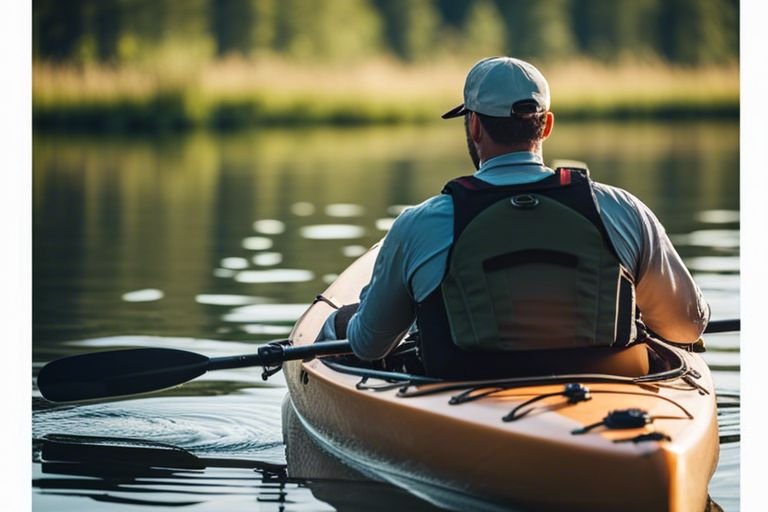
To make an informed decision, it’s crucial to weigh the pros and cons of each type of fishing kayak.
Here’s a breakdown of the advantages and disadvantages of sit-on-top, sit-in, and inflatable kayaks:
| Pros | Cons |
|---|---|
| Sit-on-Top: Stability, ease of use, self-bailing, stand-up capabilities | Sit-on-Top: Slower speed, less efficient tracking |
| Sit-in: Dry ride, better speed and efficiency, more maneuverable | Sit-in: Confined space, less stable, requires more skill |
| Inflatable: Portability, affordability, easy storage | Inflatable: Less durable, slower speed, limited customization |
| Sit-on-Top: Better for beginners, calm waters, and fishing with kids | Sit-on-Top: Not ideal for cold weather or rough waters |
| Sit-in: Suitable for cold weather, rough waters, and experienced anglers | Sit-in: Not recommended for beginners or calm waters |
| Inflatable: Great for small lakes, rivers, and tight storage spaces | Inflatable: Not ideal for open ocean or rough waters |
Sit-on-Top Kayaks: Stability vs. Speed
While sit-on-top kayaks are incredibly popular among anglers, they do come with some trade-offs. On the one hand, they offer unparalleled stability, making them perfect for beginners or those who want to fish with kids.
They’re also self-bailing, which means you don’t need to worry about water accumulating inside the kayak.
On the other hand, sit-on-top kayaks tend to be slower and less efficient than sit-in kayaks, which can be a drawback for those who want to cover more water.
That being said, many modern sit-on-top kayaks have been designed with speed and efficiency in mind.
Look for models with a sleek hull design and a narrower beam to improve tracking and reduce drag.
Sit-in Kayaks: Dry Ride vs. Confined Space
Ride comfort is a critical factor when choosing a fishing kayak, and sit-in kayaks offer a drier ride compared to sit-on-top kayaks.
This is especially important for anglers who fish in cold weather or rough waters. However, sit-in kayaks come with a more confined space, which can be a challenge for taller or larger anglers.
Additionally, sit-in kayaks require more skill and technique to maneuver, especially when it comes to getting in and out of the kayak.
If you’re new to kayak fishing, you may want to start with a sit-on-top kayak and transition to a sit-in kayak as you gain more experience.
Sit-in kayaks are ideal for anglers who prioritize speed and efficiency, as they tend to be faster and more maneuverable than sit-on-top kayaks.
Inflatable Kayaks: Portability vs. Durability
Little beats the convenience of inflatable kayaks when it comes to portability and storage. They’re incredibly lightweight and can be easily deflated and packed away in a small bag.
However, inflatable kayaks tend to be less durable than their hard-shell counterparts and may not withstand rough waters or sharp objects.
Another significant advantage of inflatable kayaks is their affordability. They’re often priced lower than hard-shell kayaks, making them an attractive option for beginners or those on a budget.
When choosing an inflatable kayak, look for models with durable materials and robust construction to minimize the risk of punctures or damage.
Conclusion
With these considerations in mind, I’m confident that you’ll be well on your way to finding the perfect fishing kayak for your next adventure.
Keep in mind, that it’s not just about the kayak itself, but about how it fits into your unique fishing style and needs.
By taking the time to think about the type of water you’ll be fishing in, your weight and gear requirements and the features that matter most to you, you’ll be able to narrow down your options and find a kayak that truly enhances your experience on the water.
As a seasoned angler, I can attest to the fact that having the right kayak can make all the difference.
It’s about finding a vessel that allows you to focus on the thrill of the catch, the tranquility of nature, and the sense of freedom that comes with gliding across the water.
With the right kayak, you’ll be able to cast your line with confidence, reel in the big ones, and create memories that will last a lifetime.
So take your time, do your research, and trust your instincts – I’m sure you’ll find the perfect fishing kayak for your next adventure.
FAQs
Q: What are the main types of fishing kayaks available, and how do they differ?
A: There are three main types of fishing kayaks: sit-on-top kayaks, sit-in kayaks, and inflatable kayaks.
Sit-on-top kayaks are popular for their stability and ease of use, offering self-bailing capabilities and allowing you to stand up for better casting and visibility.
Sit-in kayaks provide a drier ride and are better suited for colder conditions, offering more speed and efficiency, but with a more confined cockpit.
Inflatable kayaks are portable and affordable, making them ideal for anglers with limited space.
Q: What factors should I consider when choosing a fishing kayak?
A: When dicking out a fishing kayak, consider the type of water you’ll be fishing in most often, as this will influence your choice of kayak length and width.
Weight capacity is also crucial, ensuring your kayak can comfortably support your weight, gear, and potential catches.
Don’t forget to think about comfort, opting for adjustable seating with good lumbar support to prevent backaches.
Storage is another key aspect, considering the type of gear you typically carry and choosing a kayak with ample storage space.
Q: What fishing-specific features should I look for in a kayak?
A: As a minimum, look for built-in rod holders, but you can always add more depending on your fishing style.
Other necessary features include live wells for keeping bait fish fresh and mounts for fish finders to enhance your fish-finding capabilities.
Some kayaks may also offer additional features like hatches, tank wells, and bungee cords for storing your gear.
Consider what features matter most to you and your fishing style when choosing the right kayak.

